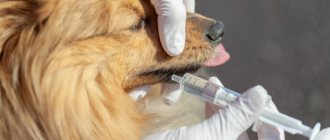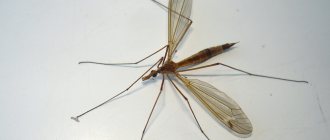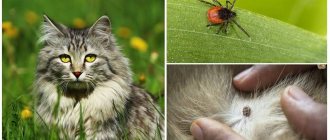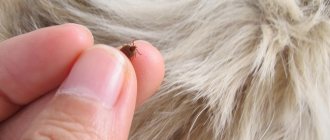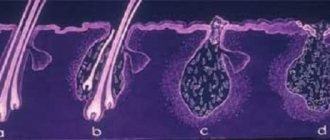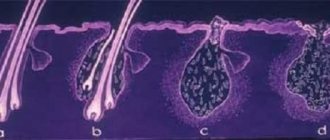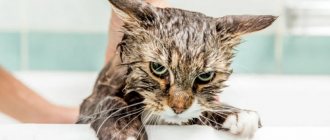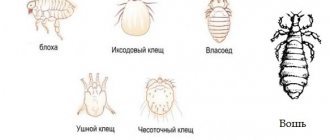Symptoms of animal infection, how to identify the parasite from a photo, why lice eaters are dangerous for cats and humans. How to treat, including traditional methods.
Cat owners take flea and tick prevention. However, they forget that lice eaters, which are no less dangerous, can also live on the body of their pets.
In this article, you will learn how to identify a lice beetle infestation and how to treat your animal without harming it.
Cat lice eaters are flightless insects about 2 millimeters in size. They have a large head, an oblong abdomen, a powerful biting apparatus, and three pairs of legs with which they cling to fur. They are yellowish in color and live on the bodies of warm-blooded animals, including cats.
The food for lice eaters are tiny particles of skin and fur, as well as dried blood.
The eggs of lice eaters are almost impossible to comb out or wash, since they are attached with a special sticky secretion, and therefore getting rid of nits is not easy.
Lice eaters are not transmitted to humans , but it is unpleasant to understand that some insects live in the house, and even more so on the body of your beloved purr, which can cause serious harm to his health.
What do lice eaters look like in cats?
Lice eaters (appearance)
Photo of a lice eater under a microscope
Scratching when affected by lice eaters
What lice eaters look like on fur
Consequences
- Hypoallergenic cats
- Why does a cat need a tail?
- Chinchilla
- Dog breeds
- Urban dog breeds
- Origin of the cat
A cat's lice eater can cause a whole series of negative consequences for the animal's health. This is especially acute in cases where treatment is ignored or carried out incorrectly. The following problems are possible: infection with tapeworms, hemobartonellosis and other diseases that lice eaters carry; acute allergic reactions, dermatitis, phlegmon and swelling in cats with sensitive skin; infectious and invasive diseases, fungi, subcutaneous mites, which easily appear on inflamed and wounded skin; hair loss and baldness; general exhaustion and anemia; exacerbation of chronic diseases.
Ways to infect cats with lice eaters
- Upon contact with a sick animal.
- From mother to kittens.
- When catching rats or mice infected with lice eaters.
- Through grooming items.
The latter method of infection is not very common, since this type of ectoparasite is drawn to warmth and will rarely linger on cool tools.
Not a single cat is immune from lice-eater infection. At risk are animals with weakened immune systems (sick, after surgery, kittens, elderly), as well as those who receive an unbalanced diet or live in uncomfortable conditions.
Lice eaters can appear in cats at any time of the year.
Causes
There can be many reasons for the appearance and ways of infection by lice eaters, among them the most common are:
- Having direct contact with an already infected animal. At the same time, a cat can pick up lice eaters not only from its relatives, but also from dogs.
- Hunting and catching infected rodents , which can also be infected with lice eaters.
- Transmission of parasites to newborn kittens from an infected mother cat.
- Poor quality of living conditions for the cat , their non-compliance with established sanitary standards.
- Increased levels of air humidity or excess dampness in rooms in which the cat spends a significant amount of time.
- Lack of complete and balanced nutrition , incorrectly selected food or poorly designed diet.
- Weakening of the immune system , which can be caused by a large number of third-party factors, including poor nutrition or previous severe forms of various diseases.
Symptoms of cat infestation with lice eaters
Lice eaters have settled on your cat's body if:
- she constantly itches, licks the fur with her tongue, tries to gnaw out an insect with her teeth;
- scratches and small blood spots, rashes, scratching, eczema, dermatitis appeared on the pet’s skin;
- bald spots appear due to hair loss;
- the cat behaves restlessly, stops obeying the owner, gets nervous for no apparent reason, ignores toys;
- sleep patterns are disrupted due to constant itching.
How can you easily distinguish lice eaters from ticks and fleas?
To do this, just hold the animal near a heat source (for example, near an incandescent lamp or an open window through which the sun shines) for several minutes. Fleas and ticks will not react to this in any way, but lice eaters will begin to actively crawl out of the depths of the fur closer to the heat source.
If your cat does have fleas, then read how to deal with them.
Clinical picture
When a lice eater is detected, the following signs appear:
- Itching.
- The appearance of small white elements resembling dandruff.
- Ungroomed appearance of the coat.
- Sharp weight loss.
- Severe anxiety.
- Distracted attention.
- Behavior change.
The lice eater causes itching in dogs.
The dog may itch severely for several days. Hair falls out so profusely that baldness occurs as a result.
The skin at the site of baldness swells and becomes wrinkled. It becomes covered with a gray crust. And also specific scabs are found on the skin.
The dog becomes very nervous and may stop listening to commands.
How to treat a cat for lice
All drugs for the treatment of ectoparasites are very toxic and can harm the health of your pet.
If affected by lice eaters, it is recommended to show the cat to a veterinarian. He will make a diagnosis, select adequate treatment, establish a safe dosage of drugs and talk about caring for the animal during treatment, as well as preventive measures. If antiparasitic drugs are used incorrectly, the cat can become seriously poisoned. To prevent this, after treatment with a gel or emulsion, it is better to put a collar on the animal that prevents the drug from being licked from the body.
Your cat should be treated for lice at least twice. The first time, the drug may not have an effect on insect eggs, but will cause the death of adults and newly hatched larvae. After 10-14 days, when repeated treatment, teenage lice-eaters who have not yet had time to produce offspring will also die.
Prevention
The following preventive measures exist:
- It is necessary to avoid contact of the cat with other homeless animals;
- Regularly inspect your pet's fur;
- Keep your pet's bedding, house and slicker clean;
- Monitor your cat’s diet and provide him with enough vitamins;
- Every 2-3 months, bathe the cat, and it is advisable to use anti-parasitic shampoo;
- If the cat goes outside, then it is necessary to put an antiparasitic collar on it, which will protect it from lice eaters, as well as from fleas.
Following these simple rules will help avoid the appearance and re-infection of these parasites.
Can it be treated at home?
If the lice-eater infestation has occurred recently and the damage is minor, you can try to treat the animal at home. To do this, you should purchase drugs against ectoparasites (fleas, ticks, lice):
- pet shampoos (“Demos-Lux”, “Flea&Tick Cat Shampoo”, “Bolfo”, “Shampoo B”, “Rolf Club”, “Mr. Kiss”, “Bars”, “Clandestine”, etc.);
- drops (“Bars”, “Clandestine”, “Biafar”, “Frontline”, “Barrier”, “Hartz”, “Advantage”);
- aerosols and sprays (“Bolfo”, “Acaromectin”, “Flea & Tick – 14 Residial Spray”, “Delix-spray”, “Serco”, “Frontline”, “KiSka”).
These medications should be used with extreme caution if lice eaters are found in a kitten.
For small animals with weak immunity, you should use a lower dosage, which your veterinarian will help you choose.
Folk remedies used by animal lovers at home are not as effective as specialized drugs. However, they may well be used in the early stages of infection. For example, an animal can be bathed in a strong decoction of chamomile, string or wormwood.
Signs of parasites
It is difficult to see them with the naked eye due to their light color, but there are signs by which their presence can be determined:
- frequent itching;
- the cat is restless, sleeps poorly;
- the cat often licks its fur and tries to chew out parasites with its teeth;
- the skin on the cat’s body peels off and wounds appear;
- The hair falls out a lot, and bald patches of skin appear.
If your cat has the above symptoms, you should carefully examine him at home. Lice eaters live in cats' fur, and they stick to their eggs in such a way that it is difficult to comb them out.
In order to see these very small insects, you need good lighting. They also like warmth, and if you sit your cat near a heater, they will be easier to see because they will emerge on the ends of their fur. If you find these parasites on your pet’s skin, you should immediately take him to see a veterinarian. Only a doctor can correctly suggest a drug that will get rid of parasites and will not harm the animal.
Types of ticks
The following types of ticks can parasitize an animal’s body:
- Ear. Parasites cause the disease otodectosis.
- Scabies pliers. Rarely found insects. They are carriers of sarcoptic mange.
- Cheyletiella mites. Another rare variety. An animal attacked by these parasites becomes infected with chylitis.
- Demodex cati mites provoke the development of demodicosis.
- Notoedres cati mites cause a disease called notoedrosis.
Medicines and injections
If this is your first time encountering this problem, it will be quite difficult for you to choose a remedy for subcutaneous mites in cats on your own. Since the disease is divided into two forms (depending on the size of the affected skin), localized and generalized. Medicines are prescribed after examination by a veterinarian.
Localized form
This form of the disease is characterized by small skin lesions. Choosing a remedy for subcutaneous mites in cats for this form is not difficult, since there is a large selection of ointments, sprays, and shampoos. The treatment is simple, the main thing is to start on time and follow the correct sequence. Remember, the drug is applied only after cleansing the skin.
Medicines for localized form:
- Sulfuric ointment;
- Aversectin ointment;
- Unoiled;
- Tsidem;
- Demos liniment;
- Amit;
- Ivermek-gel.
In addition, the animal will need a drug that will increase immunity. This could be Gamavit, Immunoparasitan, Gala-vet or Maxidin.
Generalized form
This form of demodicosis is more difficult to treat, since almost all of the animal’s skin is affected. You shouldn’t give up, even if your pet already has ulcers and severe irritation – you can cure your cat.
In order for the drug for external use to be well absorbed, it is recommended to cut the animal’s hair and bathe it with medicated shampoo. After soaking the skin with special medicinal oils and after drying, treat the affected areas with the prescribed drug. In more severe cases, injections will be needed.
Preparations for injection:
- Cydectin - single dose - 0.4 ml;
- Dectomax - the dose is calculated by the veterinarian depending on the weight of the cat.
If the disease occurs with complications, this means that a secondary infection has joined demodicosis. In this case, the doctor will prescribe antibiotic injections.
Antibiotics for complicated forms of demodicosis:
- Betamox;
- Amosin;
- Amoxicillin;
- Kanamycin;
- Baytril.
In case of a complicated form, it is important to balance your pet’s diet. Include foods fortified with minerals and vitamins. This can be boiled porridge with fish or meat, with the obligatory addition of vegetables.
Folk remedies
In parallel with traditional ones, alternative methods of therapy are used. folk recipes against askariasis:
- Infusion of leather mackerel. 1 tablespoon of dry herb is poured into about 5 liters of boiling water and set aside until it cools completely. The strained solution is diluted with 0.5 liters of water and the pet is bathed. The plant has a bactericidal effect and promotes rapid healing of wounds.
- Wounds are treated with calendula tincture. To avoid side effects, it is better to buy the product at a pharmacy and use it according to the instructions.
- Treatment of wounds with concentrated chamomile infusion. To prepare it, 100 dry plants are poured with boiling water. The cooled infusion is filtered.
Be sure to read:
Are worms transmitted from cats to humans: how, are they dangerous, what diseases do they cause, how to avoid getting infected
It is forbidden to treat leather with kerosene. The substance causes severe intoxication.
